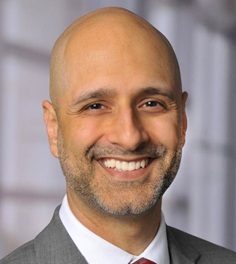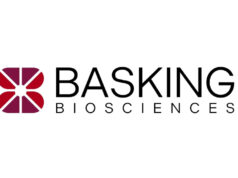
Following Basking Biosciences’ recent announcement that the first acute ischaemic stroke patients have received its novel thrombolytic therapy as part of the Phase 2 RAISE clinical trial, NeuroNews speaks to the company’s co-founder and chief medical officer—Ohio State University neurosurgeon Shahid Nimjee (Columbus, USA)—to find out what this milestone could mean for the future of stroke care.
“There’s only one drug that has been approved in stroke [in the USA],” Nimjee states, referencing the longstanding reliance on tissue plasminogen activator (tPA), also known as alteplase, in this space. “It got approved in 1995. But, it really doesn’t treat the majority of strokes. In the USA alone, we have 800,000 ischaemic strokes [each year], but national utilisation of tPA is at around 7%—about 50,000 patients—largely because it’s only usable up to 4.5 hours after stroke and there are worries over reversibility.”
In the broadest terms, tPA is indicated for ischaemic stroke, and often represents these patients’ best chance of avoiding disability and ultimately recovering from their symptoms. However, in the small but not insignificant subset of this population who experience brain bleeds following their stroke, giving tPA creates a vastly increased risk of mortality.
According to Nimjee, even the remarkable emergence and expansion of mechanical thrombectomy over the past decade—despite the procedure’s undeniably positive impact—fails to fully address the limitations surrounding stroke care today.
“It only works for large vessel occlusion [LVO] stroke,” he states. “And, even once you take the clot out, and you look at the angiogram and say, ‘look what I’ve done, I’ve refilled the brain, everything’s perfect’, the majority of patients still do poorly [in terms of clinical outcomes]. It’s believed that this is because we haven’t dealt with the ‘microcirculation’—those small clots that you can’t see on imaging but are still there causing problems.”
Given the fact that there are no studies indicating that tPA is truly effective in breaking up these microcirculation clots, Nimjee believes now is the time to move away from “antiquated” perceptions of coagulation and focus on targeting “thrombosis as we know it today”.
“I think BB-031 represents a class of drugs that will have a significant impact in terms of breaking up blood clots,” he adds. “As a first indication, I would expect to see our drug be very effective in patients who present within 24 hours from the onset of their stroke. I also see a future where it can be used alongside tPA as a synergistic treatment, as long as the safety profile of giving both proves to be acceptable.”
“While existing thrombolytics have been a critical first-line treatment strategy for acute ischaemic stroke over the last three decades, very few patients benefit from this treatment—largely due to a limited time window and limited efficacy in certain clot types,” comments Basking scientific and clinical advisory board member Ashutosh Jadhav (Barrow Neurological Institute, Phoenix, USA), also speaking to NeuroNews. “BB-031 importantly addresses these gaps by targeting clot integrity with a novel mechanism and expanding the therapeutic time window.”
What is ‘true’ thrombolysis?
“Thrombolysis as we know it today is really centred around fibrinolysis; if we break up fibrin, then we’re breaking open the clot,” Nimjee continues. “That’s based on analyses done in the 1980s from clots that were captured on the surface of heart valves during valve-replacement surgery. With thrombectomy, we’ve actually been able to analyse the clots in patients’ brains, and we’ve found that—unsurprisingly—clot composition is a lot more complex than just focusing on fibrin.”
Central to many of these analysed clots, Nimjee relays, was von Willebrand factor (VWF). Another key advancement in the scientific community’s understanding has revealed that, while coagulation occurs on the surface of platelets, thrombosis itself is not a coagulation-centric process.
“So, something targeting platelets and something targeting the stuff that holds the platelets together is just as attractive—if not more attractive—than targeting individual clotting factors or fibrin alone,” he explains.
As such, in an effort to more effectively break down blood clots, Nimjee and his colleagues have developed BB-031—a ribonucleic acid (RNA) aptamer designed to act as a highly specific antagonist to VWF, inhibiting and ultimately dismantling the VWF ‘mesh’ that binds together fibrin, platelets, collagen, red and white blood cells, and the many other constituents of a clot.
A reversible solution
This is unquestionably a novel approach to thrombolysis, and Nimjee is optimistic that BB-031 will ultimately prove to be at least as effective as established candidates like tPA and tenecteplase when it comes to clot degradation. However, the drug’s near-utopian promise of reversibility is the single characteristic that most significantly distinguishes it from anything previously seen in the world of clot-busting stroke medications.
“The idea of reversibility relates to one of the biggest problems with thrombolytics today: if you get a thrombolytic, you can bleed,” Nimjee says. “And, with thrombolytics in the setting of a stroke—according to a 1995 paper—6.4% of patients will have an intracranial haemorrhage [ICH], and 40% of patients who have an ICH die, because there’s no way to reverse the drug. You can’t turn it off; it’s going to keep acting.”
Intravenous thrombolysis—despite being a broadly safe and effective treatment in many stroke patients—increases the likelihood of haemorrhagic complications and essentially precludes any subsequent endovascular procedures to fully remove the clot. Herein lies a key positive impact of a thrombolytic agent that is reversible and can safely be ‘turned off’ by administering a second drug: it makes a potentially life-saving mechanical thrombectomy a much more feasible option with a vastly reduced risk of bleeding.
“It’s very important to understand what reversibility means,” Nimjee asserts. “Some people will say that, if you give patients cryo[precipitate], that reverses alteplase or tenecteplase. That’s not true. What cryo does is provide more clotting factors compared to the milieu in plasma, to try and offset the effects of alteplase or tenecteplase—but that’s not reversibility.”
BB-031 is an RNA molecule that folds into a three-dimensional structure and binds to VWF to inhibit its activity. Once it has accomplished this (i.e. following clot thrombolysis), a second drug called BB-025—which has a nucleotide sequence that directly complements that of BB-031—is introduced, ‘unzipping’ the three-dimensional shape of the thrombolytic and effectively switching it off.
“It [BB-025] literally acts on the active drug to turn it off without perturbing your own coagulation system or thrombotic cascade,” Nimjee adds.
This reversal occurs “within minutes”, he also relays, citing findings from the multiple animal model studies in which Basking’s two leading drug compounds have been evaluated to date.
“If you give the drug [BB-031], you have complete abrogation of coagulation,” Nimjee expands. “And, if you give the drug, wait five minutes, and then give the reversal agent, and then wait two more minutes, it’s like you never gave the drug at all. With a bolus injection of BB-025, you have durable reversal of the activity of the [thrombolytic] drug compared to just giving the drug alone.”
Nimjee’s belief is that this reversal agent may help to extinguish some of the “tribalism” that currently surrounds tPA usage in the USA, as—rather than having “no recourse” if the patient bleeds—physicians will be able to administer a thrombolytic while safe in the knowledge that it can be reversed via a second drug, even if the patient does experience haemorrhagic complications.
“Then, a surgeon can take the clot out successfully, or we can go and get a hemicraniectomy, and we can do all the interventions we need to do because we’ve turned the drug off,” he elaborates.
“While currently available thrombolytics are fairly safe, there can be post-treatment haemorrhagic complications that can be devastating with limited treatments and lack of a rapidly reversing agent,” Jadhav adds. “The reversible aspect of BB-031 will be a significant advance in our current approach to acute ischaemic stroke, both in addressing haemorrhagic complications as well as allowing reversal—when needed—to allow for the safe performance of additional surgeries that may be necessary in the post-stroke population.”
Existing data and ongoing studies
Basking’s first major showcasing of data on its reversible thrombolytic candidate came at the 2023 International Stroke Conference (ISC; 8–10 February, Dallas, USA), with Nimjee himself presenting Phase 1 study findings demonstrating the drug to be safe and tolerable in healthy volunteers.
Either side of this presentation, Nimjee also spent 18 months “in the trenches”, in his words, working alongside the company’s chief executive officer (CEO) Richard Shea to raise money and ensure Basking had enough resources to conduct a Phase 2 clinical study. These efforts came to fruition in the early stages of 2024, as the company announced the close of US$55 million in financing to further its development of BB-031 and BB-025.
RAISE—a Phase 2 proof-of-concept study—is now actively enrolling acute ischaemic stroke patients across the USA with the primary goal of proving BB-031’s acceptable safety profile in humans. In addition, the funding Basking has raised to date is being utilised to set up a Phase 1 safety study of BB-025. Nimjee’s hope is that this study will commence in mid-2025—a timeline that, if achieved, would mean the company can look to begin a future Phase 3 pivotal trial of BB-031 that also incorporates usage of its accompanying reversal agent under compassionate use in enrolled patients who experience bleeding.
“You can’t do a Phase 2 study of a reversal agent, because the number of times you’ll need the reversal agent is so little—as haemorrhage rates are 2–5%—and you’re never going to have a chance to durably [test] it,” he explains.
When queried about the possibility of a more direct head-to-head study evaluating BB-031 against tPA, Nimjee notes that Basking’s drug would likely have to demonstrate superiority versus the current gold standard among stroke patients presenting within 4.5 hours from symptom onset—and, in order to produce a sufficient effect size, said trial would therefore need to be “massive”.
“The number of patients you’d have to enrol to show that efficacy would be in the thousands—and nobody will want to do that, because it’s just too [cost-prohibitive] and the risk of it being negative is high,” he concedes.
For this reason, and also because the bleeding risks associated with tPA may “muddy” the safety signals of BB-031, Basking is set to assess its reversible thrombolytic as a standalone drug in patients presenting within 24 hours who do not receive tPA, at least initially.
“From a practical standpoint, we’ll end up getting some patients from 0–4.5 hours who don’t meet the criteria for tPA,” Nimjee continues. “But, that’ll be very limited, and most of the population will not be getting anything up to 24 hours. From a clinical standpoint, that is great, because it’s the majority of all stroke patients. In the USA, where we have a very comprehensive infrastructure for stroke care, only 14.5% of patients who are having a stroke make it to a hospital within 4.5 hours to qualify for tPA. About 86% of patients don’t, and it’s that 86% of patients I care about, because they’re getting nothing [as things stand].”
A similar point was made by Michael Hill (University of Calgary, Calgary, Canada)—Basking’s clinical programme advisor and RAISE principal investigator—following the first patient enrolments in this study: “Effectively and safely targeting recanalisation of acutely occluded intracranial arteries with novel pharmacology has the potential to expand access to treatment for stroke patients, and will address a significant unmet need in acute stroke care. Many patients are simply not eligible for current drug treatments or cannot reach a comprehensive stroke centre in time to benefit from advanced endovascular treatment.”
Nimjee concludes that, with the global expansion of thrombectomy and increasing uptake of tenecteplase—a generally cheaper alternative to tPA—in the USA, making predictions about the future landscape of stroke care is challenging, and it therefore remains to be seen whether BB-031 will work alongside or fully replace the current gold standard in thrombolysis. However, the potential wider ramifications of an effective and reversible thrombolytic drug appear to be unquestionably significant.
“We say that we’ve turned stroke into a surgical disease,” Nimjee says. “Everybody’s trying to get to thrombectomy faster and faster, and we’re building these huge infrastructure networks so we can get these clots out. But, firstly, LVOs only represent about 30% of all strokes. Secondly, we’ve always said that ‘time is brain’—the faster you can treat somebody, the better off they will be. It would be a lot better if, rather than needing me or another neurointerventionist to get into your brain and pull the clot out, you just need any doctor sitting in a local ER [emergency room] to push a drug and take care of even a fraction of LVOs.
“We are doing 50,000 thrombectomies a year in the USA, so, even if our drug only works in 20–30% of LVOs, we could be helping 15,000 patients before they get to the interventionist. That’s still material. That is a huge impact. And the other 70% of patients who don’t have LVO strokes are receiving care faster because it’s a medical disease again. You just need to push a drug.
“It’s also about redefining how we take care of stroke patients. We’ve been so focused on thrombectomy and, don’t get me wrong: thrombectomy is a fantastic procedure. The number needed to treat is three—that is a phenomenal statistic for an intervention. But, there’s still a lot that can be done with a drug—even in a fraction of patients—such that you don’t need a procedure anymore. Some [surgeons] are saying that this could put them out of business, and my answer to that is; if there’s something better, then we don’t deserve to be in business. This is not about people’s livelihoods, it’s about people’s lives.”








